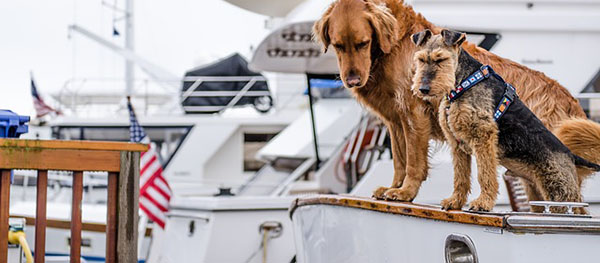Stay safe on the water with these boating safety tips
It’s Memorial Day weekend – the start of boating season in many areas. Personal lines producers, why not provide your clients with these boating safety tips, whether they’re seasoned boat operators or novices on their maiden voyage.
Operator inexperience, inattention, recklessness and speeding are the four leading causes of watercraft crashes. That’s enough to ruin your holiday weekend – and your summer. Whether your clients are waterskiing on a nearby lake, sailing in smooth harbor waters, or taking their craft up the coastline, these 12 safe boating tips will help them navigate safely and avoid a boatload of trouble.
1. Newbie operators should get their feet wet with a boating safety course. Some states require boating education; others such as California do not. Regardless, it’s a good idea, and may help clients save a bit on their insurance. Their marina will have recommendations; some community colleges offer classes; there are also online courses available. One such course is provided free by the Boat U.S. Foundation.
2. Provide (and maintain) proper safety equipment. Each person onboard should have a U.S. Coast Guard-approved life jacket, and one approved throwable device for any boat 16 feet and longer. It’s recommended that everyone wear their lifejackets while on the water. Other vital safety equipment includes a fire extinguisher and emergency supplies stowed onboard in a floating pouch: cell phone, maps, flares, and first aid kit.
3. Keep an eye on the weather. Always check local weather conditions leaving the dock. Bring along a radio in case you head into a cell phone dead zone. If you notice darkening clouds, winds that become volatile and rough or sudden drops in temperature, play it safe by heading for shore. If bad weather’s approaching, head in sooner to avoid a long waiting line at the dock.
Related: Preventing storm damage to boats
4. Develop a float plan. This boating safety tip is important if you’re boating along coastal waters or navigating a river. Share your float plan with a family member or local marina staff, so that they know where you’re going and how long you’re going to be gone. Ensure they know how to contact the Coast Guard or other rescue agency, should you not check in as planned. If you’re delayed or have a change of plans, be sure to contact them; also let them know when you’ve arrived safely back at home. The Coast Guard has a detailed float plan you can use.
5. Name an assistant skipper. More than one person on board should be familiar with general boating safety, your boat’s handling and general operations. That way, if the primary navigator is incapacitated, this back-up person who knows safe boating tips can get everyone safely to shore.
6. Don’t overload your boat. Overloading a boat with gear or passengers will make the boat unstable and more cumbersome to turn, increasing the risk of capsizing or swamping. Abide by the boat’s capacity plate, located near the boat operator’s position.
7. Use a checklist before getting underway. Following a pre-departure checklist, such as this one by the National Marine Manufacturers Association, is a good way to ensure no boating safety rules or precautions have been overlooked. Producers, you can download this checklist and provide to your boating clients as additional boating safety tips.
Related: Checklist for getting boats ready for the season
8. Follow common sense rules on the water. After leaving the boat launch, maintain slow-no-wake speed for a safe and legal distance from the launch. Always operate at safe speeds, particularly in crowded areas. Stay alert at all times with a 360-degree view of what’s happening around you. Steer clear of large vessels and watercraft that can be restricted in their ability to stop or turn. Respect buoys and other navigational aids placed to ensure your safety. Never allow passengers to ride on gunwales or seatbacks or outside of protective railings, including the front of a pontoon boat. A sudden turn, stop or start could cause a fall overboard. In a nutshell, follow all boat traffic rules.
9. Don’t boat under the influence. Yes, a cooler full of beer just seems crucial to fun. But anyone who’s had a little too much, be it the skipper or a passenger, could be big trouble. Studies show that alcohol’s effects are greatly exaggerated by exposure to sun, glare, wind, noise, and vibration. Plus, the probability of being involved in a boating accident doubles when alcohol is involved. Save it for shore.
10. Protect your dogs. Provide a shady area and keep plenty of fresh drinking water available. Since boat surfaces can get really hot, protect their feet. Make sure your pet relieves himself before boarding. If this is your dog’s first time, let her get acquainted with the boat while it’s docked; keep your first outing short so that he can get used to boat movement. Remember: not all dogs swim well, so a life vest is a good idea. View more tips here.
11. Protect your kids. Have proper safety gear: a good life jacket or life vest with a collar that flips the child face up in the water. Ensure it has a strong waist and crotch straps, a handle on the collar, and is bright yellow or orange color for good visibility. Also, attach a plastic safety whistle to the life jacket and help the child practice using it.
12. Consider a free vessel safety check. Take advantage of a free boat safety check from the US Coast Guard. Their complimentary boat examinations verify the presence and condition of certain safety equipment required by state and federal regulations; there are no consequences if you don’t pass. Their specialist will check out your boat and make helpful boating safety tips and recommendations. They also offer virtual online safety checks.
Help your clients have their best-ever summer on the water with these safe boating tips.
Resources:

